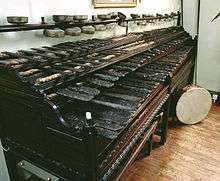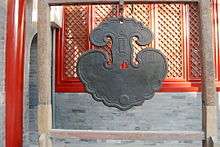Musical Stones of Skiddaw

The Musical Stones of Skiddaw are a number of lithophones built across two centuries around the town of Keswick, northern England, using hornfels, a stone from the nearby Skiddaw mountain, which is said to have a superior tone and longer ring than the more commonly used slate.[1]
The first documented lithophone from Keswick was built in 1785 by Peter Crosthwaite, an eccentric inventor who became interested in the musical properties of the local stone. However, this kind of instruments became widely known only decades later, when in 1840 Joseph Richardson, a local stonemason and self-taught musician, built a larger, eight-octave lithophone with which he and his sons toured the UK and Europe giving numerous concerts, including one in London for Queen Victoria.[2]
Richardson's lithophone initially featured 61 tuned and shaped hornfels rocks. It was later enhanced with steel bars, Swiss bells and various other percussions, and survives to this day, being on display at the Keswick Museum and Art Gallery.[1]
References
- 1 2 "The Skiddaw Stones". Soniccouture. Soniccouture Sound Design Ltd. Retrieved 24 April 2015.
- ↑ "The Musical Stones of Skiddaw". Allerdale Borough Council. Retrieved 13 Jul 2014.
